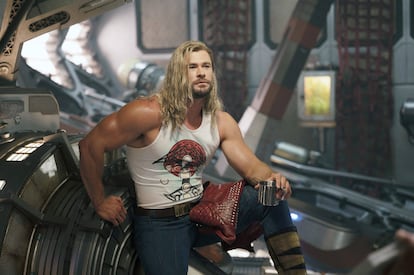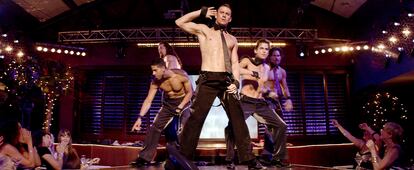Excessive muscles, padded butts and other unattainable standards: How the ‘Wonderbra culture’ now affects men
T-shirts that simulate more toning, gyms that promise to ‘Marvelify’ their members... Do the new masculine ideals perpetuate the oppressive demands already experienced by women?

“On my way to work last week, I found myself surrounded by a multitude of hunks, shirtless, running, all with smooth, hairless chests. They had extraordinarily toned muscles and every contour was extremely tanned. I felt like a misplaced extra on the set of Avengers: Infinity War,” journalist Jo Ellison recounted in June in her The Marvelification of Man column in The Financial Times, which asked: “When did everyone start looking like Chris Hemsworth?” While the comparison with the man who plays Thor may be generous to almost all men, at least, the change produced in recent years with respect to the male fixation on appearance and physical form is easily noticeable.
Ads for t-shirts designed to make the wearer look more muscular, underwear with front and back padding at, all told, very competitive prices on the most popular sales platforms, or the rise of the so-called “gym bros” (the concept that satirizes those who seem to live to exercise in the gym), with influencers spreading the gospel of the bench press all over social networks, have been shaping a kind of modern Wonderbra culture for men. The brand was conceived to emphasize the sexual attractiveness of women and it reinforced the wearers’ efforts to get nearer to the canons of beauty and body shapes that are as demanding as they are almost unreal. Likewise, superhero body shapes are the new mold for many men, either at the expense of carbohydrates, of an almost dictatorial ethic of physical work, steroids or, if necessary, optical illusion.
Images have influence. So too does each era’s understanding of the term ‘a strong man.’ In the first decade of the 21st century, a study warned of the disproportionate and unreal growth, in terms of dimensions, that action toys such as G.I. Joe were experiencing and their potential influence on children in the future development of cases of dysmorphia. In an article in The Guardian in 2019, Dr. Roberto Olivardia, an expert in male body image, also pointed to the connotation that underlies the hyperdeveloped muscles according to the time: “In the 1980s, with the warmonger Ronald Reagan, figures such as Arnold Schwarzenegger and Sylvester Stallone emerged. But in the 1970s we see very thin and androgynous men, like Mick Jagger and David Bowie, because at the time of the protest against the Vietnam War, being muscular was like declaring yourself pro-military.”
In the United States last May, the cultural journalist Manuel Betancourt published the book The Male Gazed: On Hunks, Heartthrobs, and What Pop Culture Taught Me About (Desiring) Men, a play on words around the concept of the male gaze in which the author begins by addressing a philosophical question: does desire precede images or is desire really a product of exposure to images? In other words, does a man want to have a muscly physique after the seeing the Marvel movies, or do the Marvel movies already respond to that ideal?
“I think it’s a vicious circle,” the Colombian writer says in an interview with EL PAÍS. “In the case of Marvel, it’s clear that this comes from the comics, where the bodies of the superheroes are extremely stylized, exaggerated, and always in line with the unreality of the stories. But on the big screen the movies have dictated that kind of body, there is an audience that thinks they should aspire to them, who then read interviews in Men’s Health in which the actors talk about the diets they follow and they end up feeling like there is a duty to do the same and go to the gym.”
Macho, macho man
In his book, Betancourt looks back to the days of the exaggeratedly stocky bodies of the Disney films that were considered the rebirth of animated features: King Triton in The Little Mermaid (1989), Gastón in Beauty and the Beast (1991) and, as a climax, Hercules (1997). The common denominator in these productions were the designs by the gay animator Andreas Deja, born in Poland. “He was showing the change in masculinity, particularly among gay men, that I was starting to see in Los Angeles in the late 1980s. The community was heavily afflicted by AIDS, a disease associated with almost skeletal bodies,” the author explains. “Then there was a segment of the population that tried to differentiate itself by growing and showing muscles, to express that they were healthy through their physique.”

But the strongmen of that time are not like those of today. For example, in a series like Stranger Things, a contemporary production set in the 1980s, care was taken over the “muscly” appearance of Max’s older stepbrother, Billy (Dacre Montgomery). He did not have the excessive physical power shown by solid counterparts in other current fictions, or even ordinary muscular people, because at that time such bodies were simply not seen outside bodybuilding circles. Men’s appearance changes every decade, sometimes reviving past trends; only in this case the return of the muscle has been multiplied by 1,000. The reasons can be traced not only to the external images we receive, but also to our own. The overexposure of identity that developed with the evolution of the internet has also led to the paradigm of showing the body (previously more typical of gay men and women) to shift significantly.
“You just have to go to TikTok and see these beautiful straight men dancing in basketball shorts, showing off and letting themselves be desired in a way I wouldn’t have imagined a few decades ago,” Betancourt says. “This way of offering oneself to seduction is a bit new, because, in the past, the nude was seen as a sign of vulnerability, also in emotional terms. Like you were effeminate, and you were letting yourself be emasculated.”
The writer, who is also a film critic in media such as AV Club and Variety, sees that there has also been an accompanying transformation in cinema’s sensibilities with respect to the male nude. In his book, he talks about how much he was surprised at the time by the prudishness with which a film like The Full Monty (1997), about male strippers, dealt with the sexuality of its characters. Now, he is very curious about what happens in the space that goes from that feature film to another about male strippers, the much more uninhibited Magic Mike (2012). Both are the products of heterosexual filmmakers (Peter Cattaneo and Steven Soderbergh, respectively). Betancourt finds it symptomatic that neither of the two films is conceived directly for the gay audience — “which is the one that is used to and accepts those images” — and yet present such different approaches between them.

Faced with this incipient hypermasculine cult of the body, in 2018 The New York Times proposed the emergence of an antagonistic canon in the article Welcome to the Age of the Twink, a celebration of new stars such as Timothée Chalamet, Tye Sheridan and Lukas Hedges, with the nuance that twink, in gay slang, alludes to the classic stereotype of a boyish man, because of his appearance or because he has barely passed the age of majority, and of course he is very slim. In case the heterosexual world also manages to assimilate this ideal, however, men who are too lazy to do anything with their bodies may not find the sartorial sloppiness they crave, considering the complex wardrobe choices exhibited by the star of Call Me by Your Name (2017).
A concern that makes us think of the times of metrosexuality, the cultural hallucination that occurred in the 2000s, when, suddenly, a man who shaved properly, took care of his beard or hair, adjusted his clothes a little, or maintained a certain level of hygiene became a concept in itself. “For some, it has been traumatic to now have parameters that normally only affected women and to have to think about things that as children they never thought would affect them,” says Betancourt, laughing. “These very experiences should teach us more compassion and empathy towards women, who have had to worry for decades and think about how the person sitting next to them sees them. Which is something that can be exhausting physically, psychologically, and financially.”
Sign up for our weekly newsletter to get more English-language news coverage from EL PAÍS USA Edition
Tu suscripción se está usando en otro dispositivo
¿Quieres añadir otro usuario a tu suscripción?
Si continúas leyendo en este dispositivo, no se podrá leer en el otro.
FlechaTu suscripción se está usando en otro dispositivo y solo puedes acceder a EL PAÍS desde un dispositivo a la vez.
Si quieres compartir tu cuenta, cambia tu suscripción a la modalidad Premium, así podrás añadir otro usuario. Cada uno accederá con su propia cuenta de email, lo que os permitirá personalizar vuestra experiencia en EL PAÍS.
¿Tienes una suscripción de empresa? Accede aquí para contratar más cuentas.
En el caso de no saber quién está usando tu cuenta, te recomendamos cambiar tu contraseña aquí.
Si decides continuar compartiendo tu cuenta, este mensaje se mostrará en tu dispositivo y en el de la otra persona que está usando tu cuenta de forma indefinida, afectando a tu experiencia de lectura. Puedes consultar aquí los términos y condiciones de la suscripción digital.
More information
Archived In
Últimas noticias
Most viewed
- Sinaloa Cartel war is taking its toll on Los Chapitos
- Oona Chaplin: ‘I told James Cameron that I was living in a treehouse and starting a permaculture project with a friend’
- Reinhard Genzel, Nobel laureate in physics: ‘One-minute videos will never give you the truth’
- Why the price of coffee has skyrocketed: from Brazilian plantations to specialty coffee houses
- Silver prices are going crazy: This is what’s fueling the rally











































